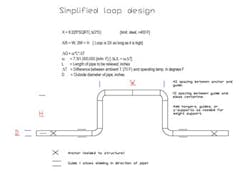THIS MONTH'S PUZZLER
We have a 500-psig high-pressure-steam top-entry ball valve that's a chronic troublemaker and that caused an emergency shutdown earlier this year. The flanges leak frequently and the stem leaks. We've replaced the valve three times this year. The body is Alloy 20 and is rated for 600 ANSI service and the spring is nickel alloy. The seat and stem seals are flexible graphite. Our safety director insists we eliminate this problem. How should we do this?
FIX THE PIPE LAYOUT
Although the valve seems perfect for this tough application, several flaws in installation compromise its performance.
The piping support puts difficult stresses on the valve. There's an old rule of thumb for water-filled pipe: Span = 6.6×N½, where N is the nominal pipe size and span is in feet. For a 6-in. pipe the maximum span should be 6.6×6½ or 16-ft. For steam the span can be greater but 23 ft is probably too wide.
As for the thermal stresses, once fluid temperatures go above 100°C some special analysis is required. For 500-psig steam, requirements will be highly severe. Linear expansion alone is significant: 0.8×(L/100 ft)×( ΔT/100°F), where it's assumed the pipe was constructed at a temperature of 100°F. For 500-psia saturated steam, the temperature is 470°F. For a 23-ft span, expansion = 0.8×(23/100)×(470/100) = 0.9 in. between the anchors. That translates to serious expansion forces. From the description of the piping, the block valve is located in the trough of the pipe. Assuming the reboiler steam nozzle is properly isolated from the expansion, the pipe anchored there absorbs a large amount of stress. To decrease the stress on the valve reduce the stress on the pipe by adding more supports and at least one pipe stress loop.
Loops don't fail -- so they're always superior to expansion joints; a simple loop follows a basic rule: height is half of width -- see Figure 1. Because of the temperature differential involved you'll need to run stress analysis software.
What about the valve? The flexible graphite in the seat and stem seals could be a problem. Flexible graphite stem seals must be carefully torqued and only once: graphite has memory.
Consider improving flange bolt tightening by pre-tensioning the bolts or changing the bolt and nut materials. In pre-tensioning, the bolt or stud is stretched; friction is replaced by uniform hydraulic loading. Pre-tensioning only works if applied evenly to all the bolts. So, you must ensure good quality control is in place for flange changes. Don't re-use either the gaskets or the fasteners with pre-tensioning. Carefully inspect a flange after every use. You might have to cut it away and replace it if it becomes stretched or mis-aligned.
Dirk Willard, contract staff engineer
Hemlock Semiconductor, Hemlock, Mich.
APRIL'S PUZZLER
We had to do a hot-tap on the top of an atmospheric tank containing crude triethylamine (boiling point: 50°C). As an extra safeguard, the approved job plan required diverting the tank's nitrogen blanket to an upper nozzle because our safety department deemed the area on top of the tank partially enclosed. Nitrogen was bubbled through a 4-ft-dia. polyethylene tank containing an aqueous 10% HCl solution; waste product overflowed the tank into a long grated drain in an area with a 6-in. dike. One side of the diked area is partially open to allow vehicle access. Plans called for scaffold erection on the first day, welding on the second day (weather-permitting) and scaffold removal on the third day. Ambient temperatures were in the mid-80°Fs. Sniff tests were performed on a periodic schedule around the work area at the top of the scaffold. A few hours into the welding, a small fire erupted several yards outside of the diked area. The safety department is investigating the accident. What do you think caused it? Is there a better way to do this welding?
Send us your comments, suggestions or solutions by March 11, 2011. We'll include as many of them as possible in the April 2011 issue and all on CP.com. Send visuals -- a sketch is fine. E-mail us at [email protected] or mail to Process Puzzler, Chemical Processing, 555 W. Pierce Road, Suite 301, Itasca, IL 60143. Fax: (630) 467-1120. Please include your name, title, location and company affiliation in the response.
And, of course, if you have a process problem you'd like to pose to our readers, send it along and we'll be pleased to consider it for publication.



